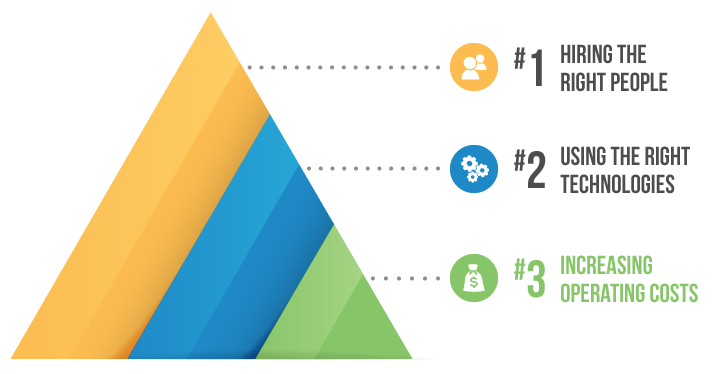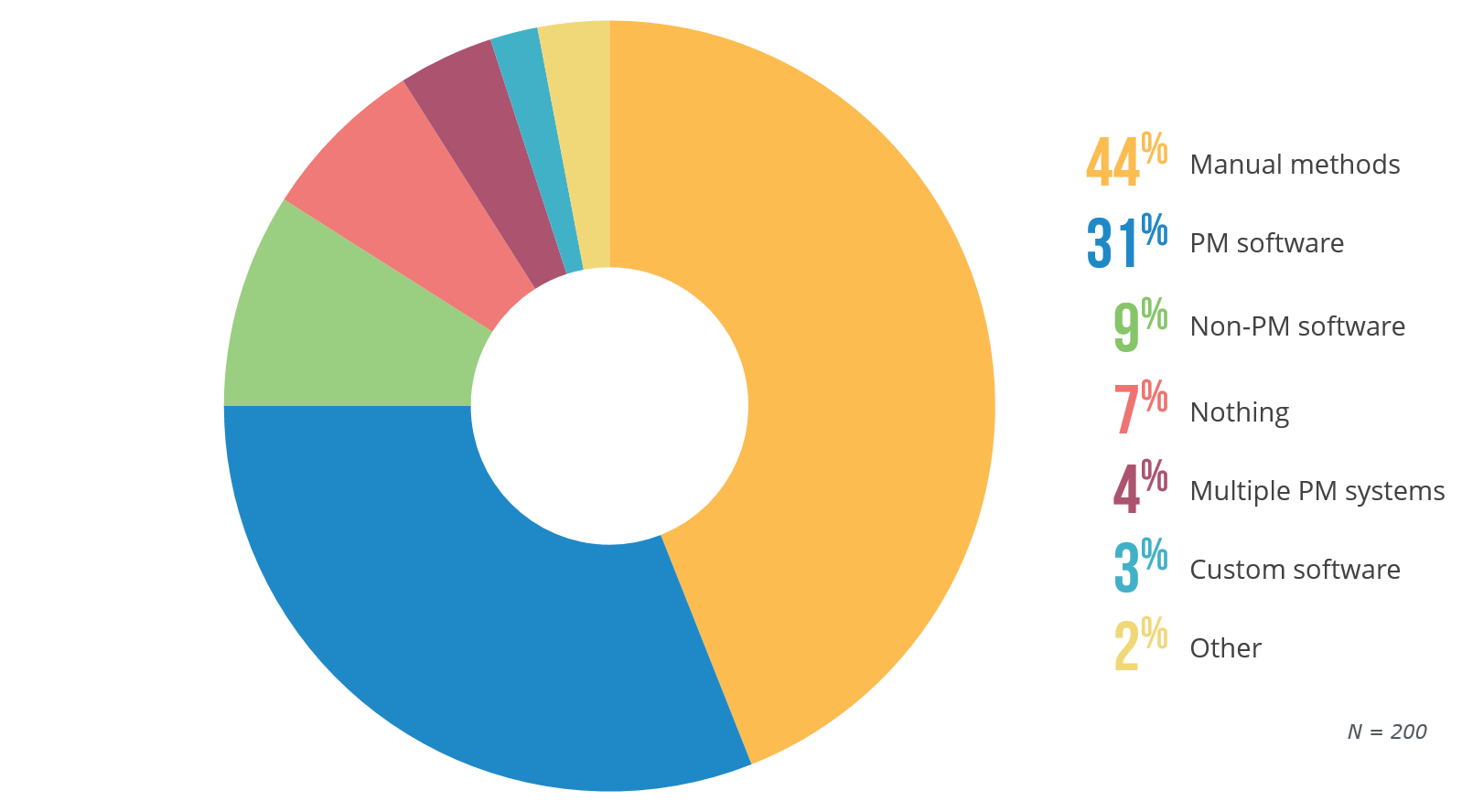3 Tips for Reducing Project Management Costs
Managing projects is no easy task, but it only gets harder when you’re worried about costs. And project managers aren’t alone—”increasing operating costs” ranks among the top three business constraints for small and midsize business (SMBs) leaders across industries, according to a recent Gartner survey1.

(Source: Gartner)
SMBs commonly cut project management costs by squeezing out the maximum value from their resources (i.e., employees), but the results of overworked employees can be quite negative.
So how do SMBs reduce operating costs without sacrificing project quality? In this report, we’ll give you three tips on how SMBs can cut project management costs while still managing projects successfully.
Here are the tips:
#1: Outsource Project Management
#2: Embrace Project Management Software
#3: Transition to Agile Processes
#1: Outsource Project Management
For a project’s success, it’s necessary that SMBs correctly plan the budget, scope and timeline of projects—commonly referred to as the “triple constraints of project management.” But balancing these constraints is not easy.
The simple rule of thumb is that businesses need to compromise on at least one of the constraints. For instance, if a business sets tight budgets and strict timelines, then there’s an expected (and often accepted) drop in project quality.
So, is it impossible for small companies to complete projects in time, at minimal costs without compromising on quality? Many project management pundits agree that the magic bullet could be outsourcing project management.
Here’s how a U.S.-based accessibility equipment dealer resolved its business challenges by outsourcing its digital marketing projects.
PROBLEM: The company’s official website was under-performing, failing to drive revenue. They wanted to improve the website’s design, add new functionality and promote it better.
SOLUTION: They outsourced the project of re-designing and promoting their website to a digital marketing agency. This included services, such as:
Creating content, including blog posts and press releases
Developing new pages to catalog products
Optimizing the website to rank on search engines
Promoting the company on social media and other channels
RESULT: They saw a threefold increase in their customer base, as their website started ranking on search engines, and improved conversions.
Why Does This Work?
While not obviously a one-size fits all solution, outsourcing project management does have its advantages. An article on Edublogs.org succinctly lays down the core benefits:
Reduces costs: Contractual workers are available in plenty, especially when you outsource projects offshore, allowing you to work with those that suit your budget.
Completes projects faster: When you outsource projects, contractual companies compete with each other which means you get more work done for the dollar.
Gets the best talent: Hiring employees from across the globe means dipping your hands into a large expertise pool and getting the best person for the job.
OUR RECOMMENDATION: The decision to outsource project management needs careful and deliberate planning. However, if you decide to “outsource,” then what you need is effective collaboration tools.
Here’s a list of project management tools that facilitate collaboration:
Social collaboration tools such as Slack or Hipchat are essential for communicating with geographically dispersed teams.
Task management tools such as Basecamp or Trello help in effectively tracking deadlines and status of projects.
For more details about tools and best practices, read our guide on how to collaborate when you outsource your project management.
#2: Embrace Project Management Software
In a recent Software Advice report, a total of 60 percent of small businesses were still using manual methods, non-project management software or nothing at all to manage projects.
How SMBs Manage Projects

(Source: Web-Based Project Management Software SMB Buyer Report – 2016)
One of the reasons why SMBs overlook project management software is that they think of it as added costs with no major benefits. While there is an upfront cost for PM tools, the long-term benefits outweigh the eventual costs that businesses incur owing to manual methods.
Here’s how Creating IT Futures (a Chicago-based nonprofit), automated manual tasks to streamline its training programs using SmartSheet—a cloud-based project management tool .
PROBLEM: The primary challenge for Creating IT Futures was managing the registration process for its training programs using a manual system like Excel. They were spending hours in manually entering and collecting data from spreadsheets, which lead to many errors.
SOLUTION: Creating IT Futures used SmartSheet to centrally collect and automatically track the data related to their training programs. Besides that, the tool was handy for:
Eliminating data errors in the registration process using web forms
Setting-up automated task notifications for teachers, students and other staff
RESULT: The non-profit saw many benefits of using a project management tool, such as improvements in productivity and cost-savings up to $25,000 a year.
Why Does This Work?
Project management software decreases administrative burden on employees, while helping businesses track tasks better and not miss deadlines. Here are the core benefits of such a system:
Automates and organizes processes: PM tools improve employee efficiency by automating different aspects of a project, such as document management. Instead of files being lost in a heap of emails, the tool helps to create a centralized repository, where team members can easily search and find important project documentation.
Utilizes resources optimally: Most project management tools come with visual dashboard reporting that helps businesses identify the skill-sets and availability of employees. With their understanding, businesses can allocate the right projects to the right employees.
Ensures deadlines are met: Ineffective tracking often results in missed task deadlines. PM tools helps to track tasks and identify potential bottlenecks, so that projects run on smoothly.
OUR RECOMMENDATION: Project management software come with different functionalities and price ranges. To make a prudent choice, you need to understand which features your business needs and only pay for what you’ll use.
The other concern is that certain software are built for enterprises and need usability training. Small businesses should avoid such tools as it adds to the workload of their overstaffed employees. Here are some further resources to get you started on project management tools:
Read our Buyer’s Guide: This beginner’s guide will help you understand the functionalities, benefits and use of project management tools.
Understand features: This is a report on the essential features of project management tools to help you make an informed buying decision.
You can also call us at (844) 680-2046 for a free consultation with a software advisor or fill this short questionnaire to get custom price quotes delivered to your inbox.
#3: Transition to Agile Processes
A common assumption is that an agile project management process is suitable only for software development companies. This is not always true. The Gartner Hype Cycle for Project and Portfolio Management, 2017 (available for clients) mentions that “agile project management will be relevant to all areas of organizations that must respond to customers and constituents quickly, because they are directly connected to them.”
One of the reasons agile has become a popular project management methodology is because it values thrift, allowing SMBs to achieve more with less.
We interviewed Ayman Nassar (a business transformation consultant) for a case study of how adopting an agile project management process helped a small businesses.
PROBLEM: Ayman oversaw a small non-profit, which was gearing up for a large fundraiser six months prior to the event date. Until six weeks prior to the event, nothing had been done except securing the facility and the guest speakers. As a consequence, very low project performance was realized and minimal pre-event ticket sales were recorded.
SOLUTION: Ayman implemented a rigorous yet simple agile project management processes, which included the following steps:
Daily touch point for 30 minutes on the phone. With a daily Scrum meeting, Ayman established transparency and the team collectively understood the progress of projects.
Work breakdown structure (WBS) update. Inspection of project goals, on a daily basis, was what Ayman did next. As a result, the team could identify what was holding them down and work on fixing those issues.
Check next day plans & distance from deliverable. Finally, with a simple analysis of their progress and examination of the next day’s goals, Ayman ensured that his team was aware of all the risks and could re-prioritize tasks to achieve the best results.
RESULT: The performance of the team boosted immediately and they reached their event ticket sales targets, while securing a dozen sponsors. The team achieved three of their primary goals, which were to get the banquet hall full, create large publicity and invite national speakers to the event.
Why Does This Work?
Agile project management allows SMBs to work within their resources and adapt to uncertainties in a project. Here are the top benefits:
Eliminates scope creep: One of the direct benefits is that it reduces cost overruns in the face of scope creep. With agile, businesses can quickly make project life cycle changes to ensure that such risks are avoided.
Eliminates risks: In agile project management, task are completed in short, iterative phases. As a result, bulky projects can be chunked into more manageable sets of tasks. This makes projects easier for a team to handle, which reduces the chances of errors and results in an improvement in project quality.
OUR RECOMMENDATION: Agile project management methodologies (such as Scrum or Kanban) are ideal for small businesses who have to manage projects on a tight budget. Also, businesses don’t necessarily need a tool to do this. However, PM tools, specifically designed for agile project management, do make planning and tracking projects easier.
Read our Buyer’s Guide on Scrum tools to get a more detailed understanding of the functionalities of agile project management tools.
If your business is transitioning to an agile project management process, then call us at (844) 680-2046 to get of list of popular tools.
Alternately, you can read our Buyer’s Guide comparing various agile project management tools.
Additional Resources
The tips mentioned above suggest project management tools to help you cut operating expenses and drive efficiency in projects. However, selecting the right tool can be tricky and expensive. To help you make an informed purchase, we have created a number of guides, some of which are mentioned below:
You can also fill out this short questionnaire to get custom price quotes for a project management tool, or call us at (844) 680-2046 for a free consultation with a software advisor.
1Gartner conducted this survey in April- May 2017 among 699 U.S.-based small and midsize businesses, with more than 10 employees and annual revenue of less than $100 million USD. The survey excluded not-for-profit organizations. The qualified respondents are decision makers, or have significant influence on the decisions related to purchasing technologies for their organization.